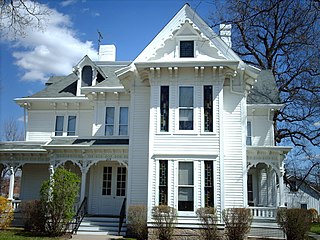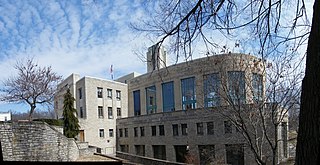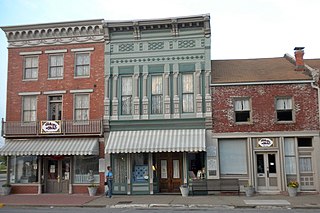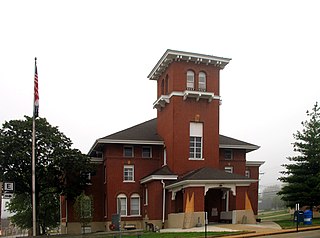
Patee Town Historic District is a national historic district located at St. Joseph, Missouri. The district encompasses 71 contributing buildings and 1 contributing site in the Patee Town section of St. Joseph. It developed between about 1858 and 1939, and includes representative examples of Greek Revival and Italianate style architecture. Located in the district are the separately listed Patee House, a hotel that is a U.S. National Historic Landmark, and Jesse James House. Other notable buildings include the Morey Piro House (1910), Charles E. Herycele House (1903), R. L. McDonald Manufacturing Co. Warehouse (1899), Mrs. Pemetia Cornish Duplex, Fred Wenz Store Building (1903), Fire Station #5 (1939), German Salems Church, and Matthew Ziebold House (1895).

The Harry S. Truman Historic District is a National Historic Landmark District encompassing sites closely associated with US President Harry S. Truman in Independence, Missouri. It includes the Truman Home at 219 North Delaware, Truman's home for much of his adult life and now a centerpiece of the Harry S. Truman National Historic Site, and the Truman Presidential Library. The district was listed on the National Register of Historic Places in 1971, and was designated a National Historic Landmark in 1974. When first listed, the district included only the two buildings and a corridor joining them. It was substantially enlarged in 2011 to include more sites and the environment in which Truman operated while living in Independence.

This is a list of the National Register of Historic Places listings in Houston County, Minnesota. It is intended to be a complete list of the properties and districts on the National Register of Historic Places in Houston County, Minnesota, United States. The locations of National Register properties and districts for which the latitude and longitude coordinates are included below, may be seen in an online map.

Halifax Historic District is a national historic district located at Halifax, Halifax County, North Carolina, US that was listed on the National Register of Historic Places in 1970 with an increase in 2011. It includes several buildings that are individually listed on the National Register. Halifax was the site of the signing of the Halifax Resolves on April 12, 1776, a set of resolutions of the North Carolina Provincial Congress which led to the United States Declaration of Independence gaining the support of North Carolina's delegates to the Second Continental Congress in that year.

Rocky Mount Historic District is a national historic district located at Rocky Mount, Franklin County, Virginia. It encompasses 211 contributing buildings, 2 contributing sites, 1 contributing site, and 2 contributing objects in the central business district and surround residential areas of Rocky Mount, county seat of Franklin County. It includes residential, commercial, institutional, and governmental buildings dated from the early- to mid-19th through early 20th centuries. Notable buildings include the Rakes Building (1929), N&W Freight Depot, Mount Pleasant (1828–1829), The Taliaffero Building (1827–1828), The Grove (1850), McCall House, Lodge Rooms (Colored), Trinity Episcopal Church, Rocky Mount Presbyterian Church, Baptist Church (Colored), N. Morris Department Store / Bryd Balm Company, Franklin County Courthouse (1909), Franklin County Jail (1938), Franklin County Library (1940), Rocky Mount Municipal Building (1929), and a Lustron house known as the Davis House (1949). Located in the district and separately listed are the Woods-Meade House and the Greer House.

Newport Historic District is a national historic district located at Newport, Giles County, Virginia. It encompasses 50 contributing buildings and 3 contributing sites in the rural village of Newport. The district includes primarily freestanding single-family dwellings or store buildings of one or two stories, featuring wood frame construction, wood siding or ornamental metal sheathing, front porches, and associated outbuildings. Notable buildings include the Epling-Dunkley[or Dunklee]-Smith House (1820s-1830s), Keister-Miller House (1846), Robert Payne House (1850s), Payne-Price House, the Miller Building, the Pent Taylor Store, the Miller Brothers General Mercantile Store, F.E. Dunkley [Dunklee] Store, Pasterfield House (1903), Dr. Walter Miller House (1903-1904), Albert Price House (1904), Methodist Parsonage (1909), Newport Methodist Church, and Sinking Creek Valley Bank (1927).

Riner Historic District is a national historic district located at Riner, Montgomery County, Virginia. The district encompasses 23 contributing buildings and 1 contributing structure in the village of Riner. It includes a variety of vernacular residential, commercial, and institutional buildings dating from the 1850s to 1920s. Notable buildings include the Methodist Episcopal Church (1908), Bank of Riner (1912–1913), Jonathan E. Hall House / Store, Kinsey-Lawrence House (1908–1909), Dr. Stone Farm, Surface Mill, Auburn United Methodist Church (1885), and Sam Barnett Store.

Valle Crucis Historic District is a national historic district located at Valle Crucis, Watauga County, North Carolina. The district encompasses 50 contributing buildings, 1 contributing site, and 7 contributing structures in the central business district and surrounding residential sections of Valle Crucis. It developed between about 1812 and 1954, and includes notable examples of Gothic Revival, Bungalow / American Craftsman, and Colonial Revival style architecture. Located in the district are the separately listed Mast General Store, Mast Farm, and Valle Crucis Episcopal Mission. Other notable contributing buildings are the Baird Farm, Lucy Mast Olsen House (1936-1940), Taylor tobacco barn, Farthing Store (1909), Valle Crucis Bank (1914), Hard Taylor House, and C. D. "Squire" Taylor House (1911).

Downtown Monett Historic District is a national historic district located at Monett, Barry County, Missouri. It encompasses 35 contributing buildings in the central business district of Monett. The district developed between about 1892 and 1947, and includes representative examples of Classical Revival and Streamline Moderne architecture. Notable buildings include the Ozark Fruit Growers Association (1926), Armstrong and Sons Grocers (1914), Wilson Opera House (1893), Zumwalt Lunch Stand (1928), Callaway Furniture Store (1916), Hoberg Building (1893), First National Bank, Main Variety (1945), Bill Martin's Chevrolet, Monett State Bank, City Hall and Fire Station, Gas Service Company and Battery Factory (1917), Post Office (1936), and Masonic Temple (1922).

Excelsior Springs Hall of Waters Commercial East Historic District is a national historic district located at Excelsior Springs, Clay County, Missouri. It encompasses 24 contributing buildings and 2 contributing structures in the central business district of Excelsior Springs. The district developed between about 1894 and 1948, and includes representative examples of Victorian architecture. The central feature of the district, the separately listed Hall of Waters, is a five level, Art Deco / Depression Modern style reinforced concrete building. Other notable buildings include the Flanders Dry Goods Store, A.M. Howard Drug Store (1905-1909), Clay County State Bank (1906), The Huey Building (1908), Oriental Bazaar Gift Store (1908), The Excelsior Baths and Broadway Rooms, Fraternal Order of Eagles Lodge Hall, The Kennedy Building (1902), First National Bank Building, The Francis Hotel, and The Auditorium.

Munichburg Commercial Historic District is a national historic district located at Jefferson City, Cole County, Missouri. It encompasses nine contributing buildings in Jefferson City. The district developed between about 1892 and 1951, and includes representative examples of Early Commercial and One and Two Part Commercial architecture. Notable buildings include the Nieghorn House Hotel (1892), Southside Barber Shop, Schmidt Shoe Store (1908), Southside Dry Goods, Milo H. Walz Hardware Store, Milo H. Walz Furniture Store (1936), Henry Schmidt Grocery Store, Central Dairy, and Busch's Florist.

Downtown Washington Historic District is a national historic district located at Washington, Franklin County, Missouri. The district encompasses 83 contributing buildings and 9 contributing structures in the central business district of Washington. The district developed between about 1849 and 1940, and includes representative examples of Greek Revival, Late Victorian, and American Craftsman style architecture. Located in the district is the separately listed Henry Thias house. Notable buildings include the St.Francis Borgia Catholic Church complex, U.S. Post Office (1922), Waterworks Building, Calvin Theater (1909), railway depot (1923), and Masonic lodge (1929).

Stafford–Olive Historic District is a national historic district located at Washington, Franklin County, Missouri. The district encompasses 140 contributing buildings in a predominantly residential section of Washington. The district developed between about 1858 and 1949, and includes representative examples of Queen Anne, Second Empire, Tudor Revival, Colonial Revival, and Bungalow / American Craftsman style residential architecture. Notable buildings include the Jos. Rumme House, Chas Haupt House, Louis Horn House, F. R. Pelster House, Hydecker House, Stephen Filla House, Chas. Kopp House, Hy. Thias Honse, and William Pace House (1929).

New Franklin Commercial Historic District, also known as Downtown New Franklin, is a national historic district located at New Franklin, Howard County, Missouri. The district encompasses 19 contributing buildings and 1 contributing object in the central business district of New Franklin. It developed between about 1894 and 1931 and includes representative examples of Queen Anne and Romanesque Revival style architecture. Notable contributing resources include the John B. and Logie R. Fleet House, U.S. Post Office, Home Electric Company Office, Carpenter and White Building, Bethke's German Cash Store (1909), Citizen's Bank (1894), and Santa Fe Trail Marker (1913).

Broadway District is a national historic district located at Hannibal, Marion County, Missouri. The district encompasses 28 contributing buildings in the central business district of Hannibal. It developed between about 1866 and 1934, and includes representative examples of Italianate, Classical Revival, and Art Deco architecture. Notable buildings include the Lakenan Building, Kresge Building (1931), Second Farmers and Merchants Bank, Sproul-Cash Store (1901), Hannibal Trust Company (1909-1910), Hickman Block, and Robinson Brothers.

Mark Twain Historic District is a national historic district located at Hannibal, Marion County, Missouri. The district encompasses 20 contributing buildings in the central business district of Hannibal. It developed between about 1840 and 1936. Located in the district is the separately listed Mark Twain Boyhood Home. Other notable buildings include the Ice House Theatre, Randall House Antiques, Information Center, House of the Pilasters & Grant's Drug Store (1839-1844), "Becky Thatcher" House, and the Mark Twain Memorial Lighthouse (1936).

Central Park Historic District is a national historic district located at Hannibal, Marion County, Missouri. The district encompasses 261 contributing buildings, 1 contributing site, and 4 contributing structures in a predominantly residential section of Hannibal. It developed between about 1840 and 1939, and includes representative examples of Romanesque Revival, Late Victorian, and Art Deco architecture. Located in the district are the separately listed Federal Building, Hannibal Old Police Station and Jail, and Eighth and Center Streets Baptist Church. Other notable contributing resources include Central Park with a war memorial monument and a life-size bronze statue of William Henry Hatch (1833-1894), City Hall (1909), old Missouri Guaranty Building (1894), Price Apartments (1904), YMCA (1910), Masonic Temple (1882), Park Methodist Church, Retards Row (1855), Elks Building (1925), Holmes Building, Security Building (1912), Kerchival-Iakenan-Lathrop House, Admiral Coontz Birthplace, Inmaculate Conception Chapel (1854), Episcopalian Trinity Church (1860), and William C. Henn House (1937).

Bonnots Mill Historic District is a national historic district located at Bonnots Mill, Osage County, Missouri. It encompasses 98 contributing buildings in the central business district and surrounding residential sections of Bonnots Mill. The district developed between about 1840 and 1942, and includes representative examples of Bungalow / American Craftsman and I-house architecture. Located in the district is the separately listed Dauphine Hotel. Other notable buildings include the Bonnots Mill School (1889), Henry Dieckriede House, Bonnots Mill United Methodist Church (1915), Bank of Bonnots Mill (1907), Bonnet's Mill Hotel / Krautman's Store, Meyer-Morfeld Milling Company, United States Post Office, St. Louis Parish Church and Rectory (1907), and St. Louis Parish School.

The Sedalia Commercial Historic District is a national historic district located at Sedalia, Pettis County, Missouri. It encompasses 102 contributing buildings in the central business district of Sedalia. The district developed between about 1870 and 1959, and includes representative examples of Italianate, Romanesque Revival, and Art Deco architecture. Located in the district are the separately listed Hotel Bothwell, Building at 217 West Main Street, and Missouri/Sedalia Trust Company. Other notable buildings include the First United Methodist Church (1888-1891), Pettis County Courthouse (1924), Anheuser Busch Bottling Works, the New Lona Theater (1920), Citizens National Bank Building, Third National Bank (1929), Federal Building (1930), Montgomery Ward Building (1936), the Uptown Theatre (1936), Missouri Pacific Depot, and Central Presbyterian Church.

























